Long wavelengths like red light can help combat your winter depression through specific calming effects on your brain and body. While blue light works well for resetting your circadian rhythm, red light therapy induces relaxation and reduces irritability – key factors in managing seasonal mood changes. You'll find that red light triggers a unique response in your limbic system, particularly the amygdala and hippocampus, helping to regulate emotional processing. When combined with broad-spectrum white light therapy, you'll get the most thorough treatment for seasonal affective disorder. There's much more to discover about how different light wavelengths can transform your winter mood.
Understanding Light Wavelengths and Mood
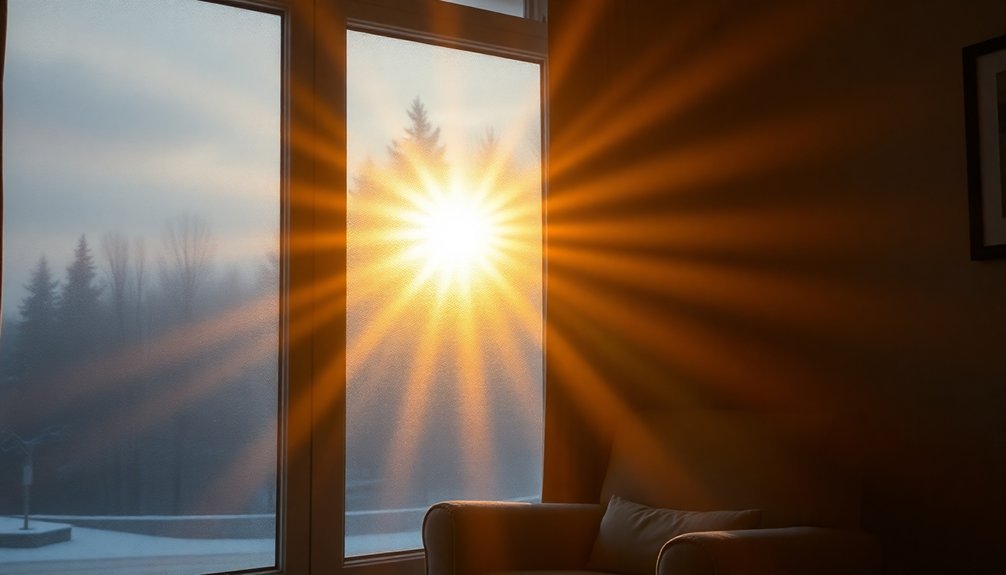
When light enters your eyes, it triggers both direct and indirect effects that shape your mood and mental state. Through specialized cells in your retina called ipRGCs, light directly activates brain regions responsible for processing emotions and executive functions, particularly when you're exposed to blue wavelengths.
Light's impact on your mood also works through your body's circadian rhythms. These internal biological clocks rely on consistent light exposure to maintain proper timing. Bright morning light helps advance your sleep-wake cycle to promote earlier bedtimes.
When you experience irregular light patterns, it can disrupt your circadian system, leading to mood disturbances and sleep problems. The wavelength of light matters substantially – blue light strongly suppresses melatonin production, while red light has minimal effect on your sleep-wake cycle.
You'll experience different emotional responses depending on the color of light you're exposed to. Red light can markedly influence your feelings of calmness and irritation, while blue light enhances alertness and performance.
The timing of your light exposure is vital too – the same wavelength can affect you differently depending on when you encounter it during the day.
Red Light Therapy Science
Building on our understanding of light wavelengths, red light therapy offers a specific therapeutic approach that harnesses longer wavelengths for healing. This treatment uses low-level red light wavelengths that penetrate your skin and stimulate cellular activity without generating heat.
When you undergo red light therapy, the light targets your cells' mitochondria, prompting them to produce more ATP energy. This boost in cellular energy triggers several beneficial responses in your body, including increased blood flow, reduced inflammation, and enhanced collagen production.
You'll find that this process can help with various conditions, from skin concerns like wrinkles and stretch marks to inflammatory conditions such as rheumatoid arthritis. For optimal safety during treatments, protective eyewear is necessary to prevent potential damage to your eyes.
While you might be intrigued by red light therapy's potential, it's important to understand its limitations. Though it's showing promise for many health applications, it's not as effective as blue light for treating Seasonal Affective Disorder (SAD).
Scientists are still working to determine the ideal wavelength combinations and treatment protocols. You'll want to note that while research supports many of its benefits, some applications still need more clinical evidence to confirm their effectiveness.
Seasonal Depression Treatment Options
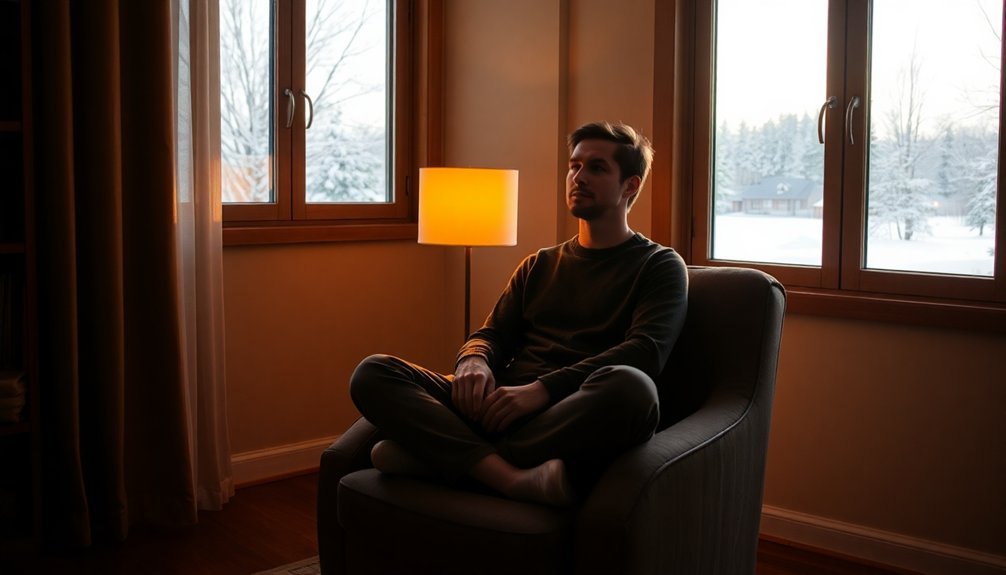
Winter's grip on mental health can be fierce, but multiple treatment options exist for managing Seasonal Affective Disorder (SAD). You'll find that healthcare providers often recommend a combination of therapies tailored to your specific needs, ensuring the most effective treatment approach. A consistent course of SSRIs can take 4-6 weeks to reach full effectiveness.
Light therapy stands out as a primary intervention, particularly when you use it in the morning hours. By exposing yourself to bright light that simulates sunlight, you're helping regulate your body's melatonin and serotonin levels. The effects can emerge within days, making it a relatively quick-acting solution.
Three core treatment pillars for SAD include:
- Cognitive Behavioral Therapy (CBT) to reshape negative thought patterns and build healthier coping mechanisms
- Antidepressant medications, especially SSRIs, to regulate brain chemistry throughout the winter months
- Preventive self-care strategies, including regular exercise and consistent sleep schedules
You don't have to wait until symptoms become severe to take action. Working with your healthcare provider, you can develop a prevention plan that incorporates these treatments before winter arrives.
Many people find success by combining multiple approaches, particularly when they start treatment early in the season.
Light Box Selection Guidelines
Selecting the right light box for SAD treatment requires careful attention to several critical features. Your light box should deliver 10,000 lux of white light through a UV-filtered screen that's at least 12 x 17 inches in size. You'll need to position it 10-14 inches from your face at a 30-degree angle above your head for maximum effectiveness. Light boxes made for SAD treatment should have a color temperature of 5,000 to 7,000 K to properly simulate natural daylight.
Before starting light therapy, consult your healthcare provider, especially if you have eye conditions or bipolar disorder. While the FDA doesn't regulate light boxes for SAD treatment, you can check reliable resources like the Center for Environmental Therapeutics for guidance.
Don't let aesthetics override effectiveness when choosing your device. You'll need to use your light box consistently for 30-45 minutes each morning throughout fall and winter.
While prices range from $70 to $400, prioritize models that meet the essential specifications over cheaper alternatives that mightn't deliver sufficient light. Remember to check your insurance coverage, as some providers may help with the cost.
For best results, consider combining light therapy with other treatments like antidepressants or psychotherapy under medical supervision.
Benefits of Broad Spectrum Light
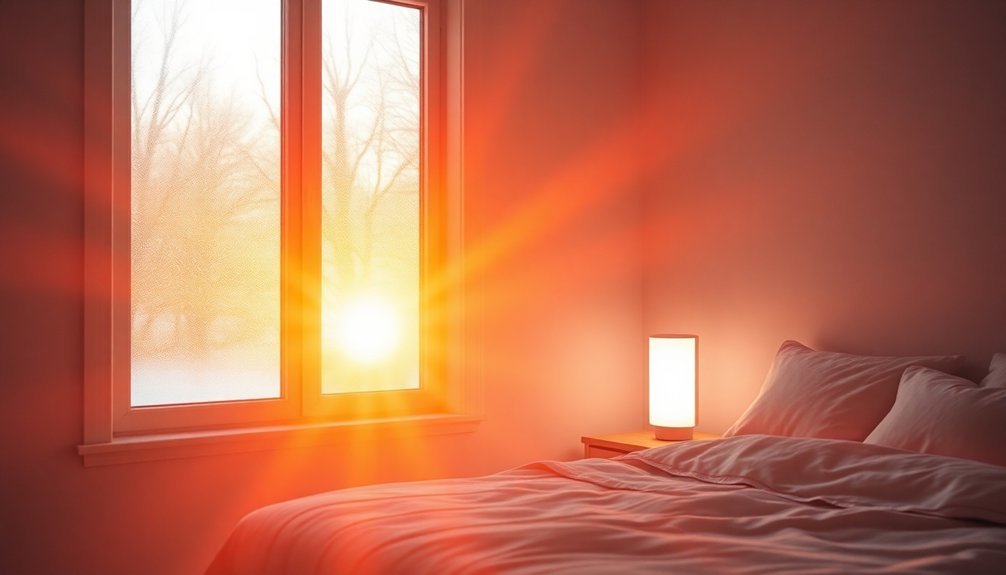
Once you've chosen the right light box, understanding how broad spectrum light works can help you maximize its benefits.
When you expose yourself to broad spectrum light, specialized cells in your eyes convert light into neural signals that regulate your mood and alertness. This process helps maintain your circadian rhythm by suppressing melatonin in the morning while boosting serotonin levels throughout the day.
Broad spectrum light is particularly effective because it mimics natural sunlight without harmful UV rays. At 10,000 lux intensity, just 30 minutes of morning exposure can substantially improve your winter depression symptoms. Unlike single-color alternatives such as blue, green, or red light therapy, broad spectrum light delivers extensive therapeutic benefits.
Key advantages you'll experience with regular use include:
- Enhanced mood regulation through balanced melatonin production
- Improved sleep patterns due to proper circadian rhythm alignment
- Increased daytime energy levels from optimized serotonin release
As a clinically proven first-line treatment for SAD, broad spectrum light therapy offers you an accessible, safe, and effective way to combat winter depression without prescription medications.
Natural Sunlight Versus Artificial Light
A clear distinction exists between natural sunlight and artificial light therapy when treating seasonal affective disorder (SAD). Studies show that natural sunlight offers superior therapeutic benefits, with 50% of patients achieving remission after just a one-hour morning walk outdoors, compared to only 25% with low-dose artificial light therapy.
While you can benefit from artificial light therapy using devices that emit 2,500 to 10,000 lux of full-spectrum fluorescent light for 20-30 minutes daily, natural sunlight produces more thorough effects on your body.
You'll notice that natural light exposure substantially improves depression self-ratings and helps regulate your body's cortisol and melatonin levels more effectively than artificial alternatives.
If you're using artificial light therapy, you'll need to maintain a consistent routine, typically sitting near a light box daily. However, if you have access to natural sunlight, you should prioritize outdoor morning exposure.
Natural light's ability to phase-advance melatonin secretion makes it particularly effective for treating SAD symptoms. While both options can improve your mood, natural sunlight's complete spectrum and higher intensity provide more pronounced therapeutic effects than standard artificial light treatments.
Wavelength Impact on Brain Chemistry
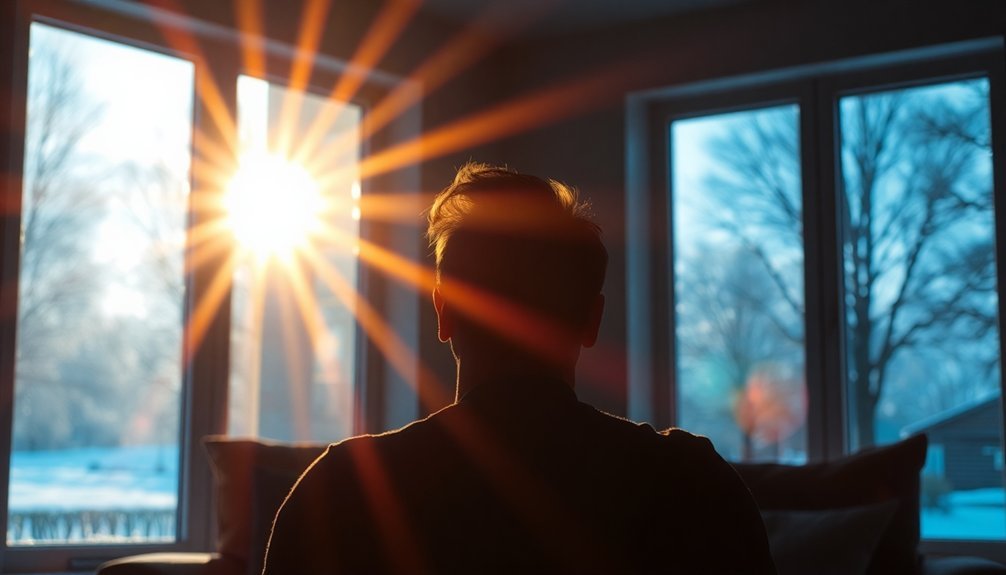
Research into light wavelengths reveals deeper insights about how different types of light affect your brain's chemistry. White light, which contains a broader spectrum of wavelengths, proves more effective than single-color lights in treating winter depression. This effectiveness stems from white light's ability to influence multiple brain regions simultaneously, including your prefrontal cortex and limbic system.
Your brain's response to light involves complex interactions between different neural pathways and neurotransmitters. When you're exposed to appropriate wavelengths, your brain adjusts its chemistry in three essential ways:
- Increases serotonin production, helping stabilize your mood and combat depressive symptoms
- Regulates gamma oscillations in your olfactory bulb, which plays a critical role in emotional processing
- Normalizes brain connectivity patterns, particularly in regions like the hippocampus and piriform cortex
The therapeutic benefits of longer wavelengths work through photobiomodulation, a process that helps repair neural connections and restore proper brain function. You'll find this especially relevant during winter months when natural light exposure decreases, as these wavelengths can effectively supplement your brain's light requirements for better mood regulation.
Therapeutic Light Treatment Schedule
You'll get the most benefit from light therapy when you begin your session within an hour of waking up, typically for 30-60 minutes each morning.
For consistent results, you should maintain a regular schedule with daily sessions, even if you initially experience improvements in your symptoms.
While morning sessions work best for most people year-round, you might need to adjust your treatment time as seasonal daylight hours shift, especially during the darker winter months.
Best Time For Treatment
Getting the timing right for light therapy can make the difference between modest and remarkable results. When you time your light therapy correctly, you'll boost your chances of remission from 35% to an impressive 80%.
The most effective approach is scheduling your light exposure immediately after waking, particularly if you're dealing with seasonal affective disorder (SAD).
To maximize your treatment's effectiveness, consider these key timing principles:
- Your best treatment window occurs 8.5 hours after your natural melatonin onset, which can vary by up to four hours between individuals
- If you can't measure melatonin onset, aim to start light therapy 2.5 to 3.5 hours after your sleep cycle's midpoint
- Short sleepers should use lights near their normal wake time, while longer sleepers need to wake earlier for treatment
You'll want to use a light source of approximately 10,000 lux for about 30 minutes. While some studies suggest timing flexibility, morning sessions typically work better than evening exposure because they advance your circadian rhythm rather than delay it.
Duration Between Light Sessions
Now that you understand the best timing for your light therapy sessions, establishing a consistent treatment schedule will strengthen your results. You'll want to space your sessions carefully throughout the week, with the ideal frequency being either daily or 3-4 times weekly. When starting treatment, begin with 20-30 minute sessions, gradually working up to 60 minutes as your body adjusts.
For the best therapeutic outcome, maintain regular intervals between your sessions. Here's a practical breakdown of session scheduling options:
| Frequency | Session Length | Total Weekly Time |
|---|---|---|
| Daily | 20-30 min | 140-210 min |
| 4x Weekly | 45 min | 180 min |
| 3x Weekly | 60 min | 180 min |
| Daily AM | 30 min | 210 min |
| Split Daily | 2x 20 min | 280 min |
Remember that you'll need at least three weeks of consistent treatment to notice significant improvements. Don't skip sessions randomly, as this can disrupt your circadian rhythm adjustment. If you're splitting sessions, keep them within the recommended 1.5-2 hours total daily exposure time, and avoid late afternoon or evening sessions unless specifically prescribed by your healthcare provider.
Adapting Schedule To Seasons
The changing seasons require strategic adjustments to your light therapy schedule, particularly if you live in northern regions where daylight hours fluctuate dramatically. You'll need to begin your therapy in early fall, ideally by October or November, to prevent the onset of winter depression symptoms.
Maintaining consistency in your schedule while adapting to seasonal changes is essential for the best results.
Your location's latitude directly impacts how you'll need to adjust your light therapy routine. The further north you live, the earlier you should start treatment and the more essential it becomes to maintain regular sessions throughout the winter months. You'll want to continue your treatment until natural daylight hours increase markedly in spring.
To effectively adapt your schedule to seasonal changes:
- Monitor your local sunrise and sunset times to align your morning light therapy with natural daylight patterns
- Increase session frequency during the darkest winter months to compensate for reduced natural light exposure
- Gradually reduce therapy duration as spring approaches, but maintain consistency to prevent symptom recurrence
Remember to keep your light box positioned 12-18 inches from your face during each session, regardless of seasonal adjustments.
Frequently Asked Questions
Can Long-Wavelength Light Therapy Interfere With Prescription Medications?
You should be cautious as long-wavelength light therapy can interact with photosensitizing medications like antibiotics, NSAIDs, and antimalarials. It's best to consult your doctor and wait 5 days after stopping these medications.
How Does Ambient Room Lighting Affect Light Therapy Effectiveness?
Your ambient room lighting can reduce light therapy's effectiveness since it only provides 114-307 lux. You'll get better results by using dedicated light therapy with 2,500+ lux in a controlled setting.
Are There Specific Eye Exercises Recommended During Light Therapy Sessions?
You don't need to perform any specific eye exercises during light therapy sessions. Just sit normally in front of your light box and keep your eyes open while going about your morning routine.
Do Tanning Beds Provide Similar Benefits as Light Therapy Boxes?
No, you won't get similar benefits from tanning beds. Unlike light therapy boxes that treat SAD through visible light entering your eyes, tanning beds use harmful UV radiation and don't address the brain's chemical imbalances.
Can Light Therapy Cause Vitamin D Production Like Natural Sunlight?
Yes, you'll get vitamin D production from specific UVB light therapy devices, like SOLIUS. While regular light boxes don't produce vitamin D, specialized UVB therapy can mimic sunlight's ability to trigger vitamin D synthesis.
In Summary
You'll find that long wavelength light therapy offers an effective, science-backed solution for winter blues. By choosing a light box with broad spectrum coverage and red light components, you're targeting the brain's mood-regulating systems directly. Whether you're using artificial light or maximizing natural sunlight exposure, consistent daily sessions will help reset your circadian rhythm and lift your spirits during darker months.

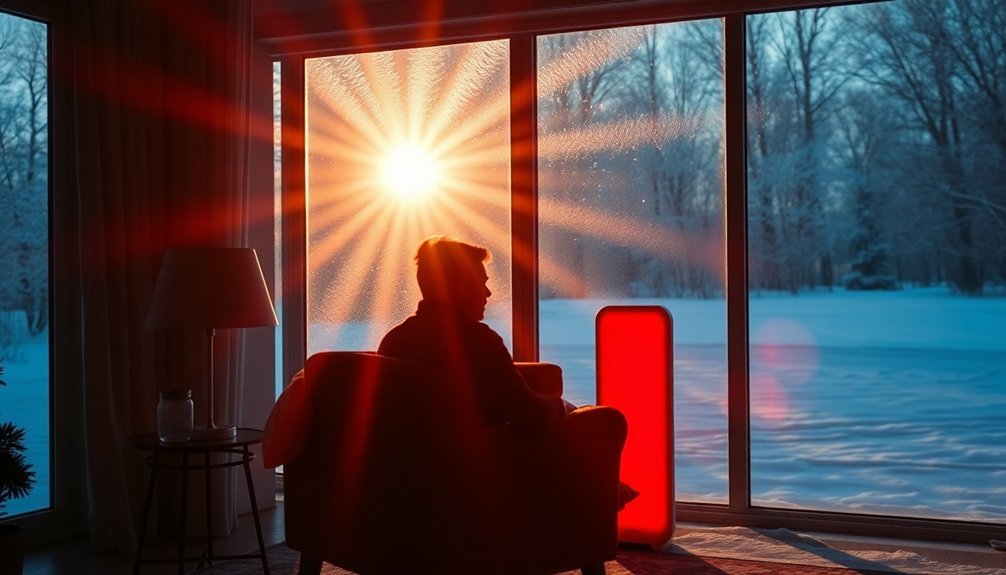



Leave a Reply